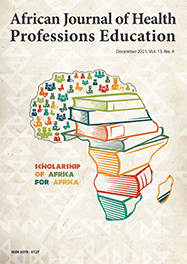One-on-one consultation on protocol development and statistics analysis in health sciences postgraduate students
School of Clinical Medicine, Faculty of Health Sciences, University of the Witwatersrand, Johannesburg
Correspondence to: Elena N Libhaber (Elena.Libhaber@wits.ac.za)
Introduction
According to publications in the UK and USA1 there is a lack or limitation in the knowledge of research methodology, statistics, and critical appraisal skills of medical literature evaluation among registrars and clinicians. As a consequence, utilisation of biostatistical consultation services became necessary and is provided in the most prestigious academic hospitals and medical schools of the world.4 In South Africa (SA) as a result of rules changes by the Health Professional Council of SA (HPCSA) to become a specialist, a compulsory qualification in research was added. Therefore courses in research methodology, applied statistics and scientific writing were implemented since 2007 at the University of the Witwatersrand and from 2009 biostatistical consultations were conducted.
In order to evaluate the utilisation of biostatistical services at the academic medical platform of the Faculty of Health Sciences, a review of one-on-one consultations was undertaken. Thus the purpose of this study was to determine the extent and the utilisation of the one-on-one biostatistical consultations during the year 2010 at the Medical School of the University of the Witwatersrand.
Methods
Consultations were performed by one research methodologist and statistical expert at two academic medical institutions of the University of the Witwatersrand (Medical School and at Chris Hani Baragwanath Academic Hospital) between January and December 2010. Every consultation was counted separately regardless of the number of times needed to address the same project. Each session was booked in advance and the duration ranged between 40 and 60 minutes. The results presented in this study were completed and compiled by the expert from data collection sheets which included consultees’ position and field, date, nature and/or purpose of the consultation and type of project. Data were reported as frequencies and percentages with the correspondent 95% confidence interval (CI95%) for each institution as well as for the combined sites.
Results
In total 235 one-on-one biostatistical consultations were performed at two academic medical institutions of the University of the Witwatersrand between January and December 2010. A total of 144 consultations, 61%, CI95% (55 - 67%) and 39 %, CI95% (49 - 61%) were completed at Medical School and Chris Hani Baragwanath Academic Hospital.
Biostatistical consultations were divided into two wide topics: research protocol development (study design, sample size calculation, etc.) and statistical analysis (data entry, data coding, appropriate statistical tests and results interpretation) which represented 35%, CI95% (29 - 41%) and 65%, CI95% (59 - 71%) of the consultations respectively.
Fig. 1 shows the distribution of biostatistical consultations per site, according to consultees and purpose of the consultation. The majority of the consultees were medical doctors seeking advice to get degrees such as Master in Medicine and PhD; 55% (129/235) and 19% (45/235) respectively, rather than medical students or staff researchers working for the University of the Witwatersrand with non-degree purpose.
The median and range of consultations per month at Medical School and at Chris Hani Baragwanath Academic hospital were 12 (8 - 17) and 7 (0 - 20), respectively.
The more frequent medical fields of the consultees were psychiatry (30%) followed by emergency medicine/family medicine (16%) and anaesthetics (15%) at the medical school site. However, at the Chris Hani Baragwanath academic site internal medicine was the department with more bookings (34%), followed by anaesthetics (18%) and psychiatry (12%).
Conclusions
The results of this study were similar to those found in several academic research institutions between 1999 and 2005 in the USA.4 Changes in critical legislation provided the catalyst for many clinicians training to be specialists to embark on research which they may not have done, given their high workloads in delivering healthcare. These changes also unveiled the previously hidden anxieties of being unable to cope with research, in particular statistics. Courses were put in place and immediately were over-subscribed. Ultimately the success or otherwise of these courses will be measured in throughput rates. South Africa is a country desperately short of doctors and specialists and research requirements should not become a limitation to qualifying.
Conflict of interest: None.
Ethics: A waiver was received from the HREC (Medical) Faculty of Health Sciences, University of the Witwatersrand.
References
1. West CP, Ficalora RD. Clinician attitudes toward biostatistics. Mayo Clinic Proc 2007;82(8):939-943.
2. Miles S, Price GM, Swift L, Shepstone L, Leinster SJ. Statistics teaching in medical school: Opinions of practising doctors .BMC Medical Education 2010;10:75.
3. Rao G, Kanter SL. Physician numeracy as the basis for an evidence-based medicine curriculum. Acad Med 2010;85:1794-1799.
4. Deutsch R, Hurwitz S, Janosky J, Oster R. The role of education in biostatistical consulting. Statist Med 2007;26:709-720.
5. Parker RA. Estimating the value of an internal biostatistical consulting service. Statist Med 2000;19:2131-2145.
6. Lesser ML, Parker RA. The biostatistician in medical research: allocating time and effort. Statist Med 1995;14:1683-1692.
1. Fig. 1. Biostatistical consultations per site.
Article Views
Full text views: 6821




.jpg)
Comments on this article
*Read our policy for posting comments here